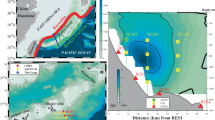Abstract
To investigate the fluctuation of the Kuroshio front, moored current meters were deployed near the shelf break and on the continental slope in the East China Sea, northwest of Okinawa Island, during a period from 25 June to 22 July 1984. Two mooring arrays were deployed on the slope of about 800 m water depth (under the Kuroshio), about 30 km apart along the path of the Kuroshio. Another two arrays were set near the shelf break of about 300 m water depth.
The fluctuation of current on the slope is found to have a predominant period of 11–14 days and a were length of 300–350 km, propagating toward the downstream direction of the Kuroshio with a phase velocity of about 30 cm sec−1. When the Kuroshio front approaches the shelf break and the crest of the meander covers the mooring site, the current direction moves toward the downstream direction of the Kuroshio and the water temperature increases. On the other hand, when the trough of the meander covers the mooring site, the current direction changes off-shoreward across the Kuroshio or in the upstream direction of the Kuroshio, and the water temperature decreases. Three-dimensional distributions of water temperature and salinity around the mooring site were observed with a CTD twice at 5.5 days intervals, which indicate the meanders of the front is about 180° out of phase. This coincides with a period of 11–14 days obtained with the moored current meters. Wave lengths of the dominant meander of the front in the satellite thermal images were about 350 km and 100–200 km, which also coincides with results obtained with the moored current meters.
Similar content being viewed by others
References
Eguchi, I., A. Shibata, Y. Takano and S. Minato (1982): Mesoscale disturbances in the Kuroshio front in the East China Sea. Report of Kuroshio Exploitation and Utilization Research,5, 104–111.
Ichikawa, H., T. Takahashi and A. Maeda (1983): Oceanic conditions in the continental shelf margin. Bull. Japanese Soc. Fish. Oceanogr.,43, 21–26.
Ichikawa, H. and T. Yamashiro (1987): CTD observation off Cape Toi-misaki and direct current measurements in the Okinawa Basin. Preliminary report of KH-84-2, Ocean Res. Inst., Univ. of Tokyo, 17–19.
Lee, T.N. and L.P. Atkinson (1983): Low-frequency current and temperature variability from the Gulf Stream frontal eddies and atmospheric forcing along the southeast U.S. outer continental shelf. J. Geophys. Res.,88(C8), 4541–4567.
Miyaji, K. and N. Inoue (1983): Characteristics of the flow of the Kuroshio in the vicinity of Senkaku Islands. Bull. Seikai Reg. Fish. Lab.,60, 57–70.
Nagata, Y. and K. Takeshita (1985): Variation of the sea surface temperature distribution across the Kuroshio front in the Tokara Strait. J. Oceanogr. Soc. Japan,41, 244–258.
Shibata, A. (1983): Meander of the Kuroshio along the edge of continental shelf in the East China Sea. Umi to Sora,58, 113–120.
Author information
Authors and Affiliations
Rights and permissions
About this article
Cite this article
Sugimoto, T., Kimura, S. & Miyaji, K. Meander of the Kuroshio front and current variability in the East China Sea. Journal of the Oceanographical Society of Japan 44, 125–135 (1988). https://doi.org/10.1007/BF02302619
Received:
Revised:
Accepted:
Issue Date:
DOI: https://doi.org/10.1007/BF02302619




